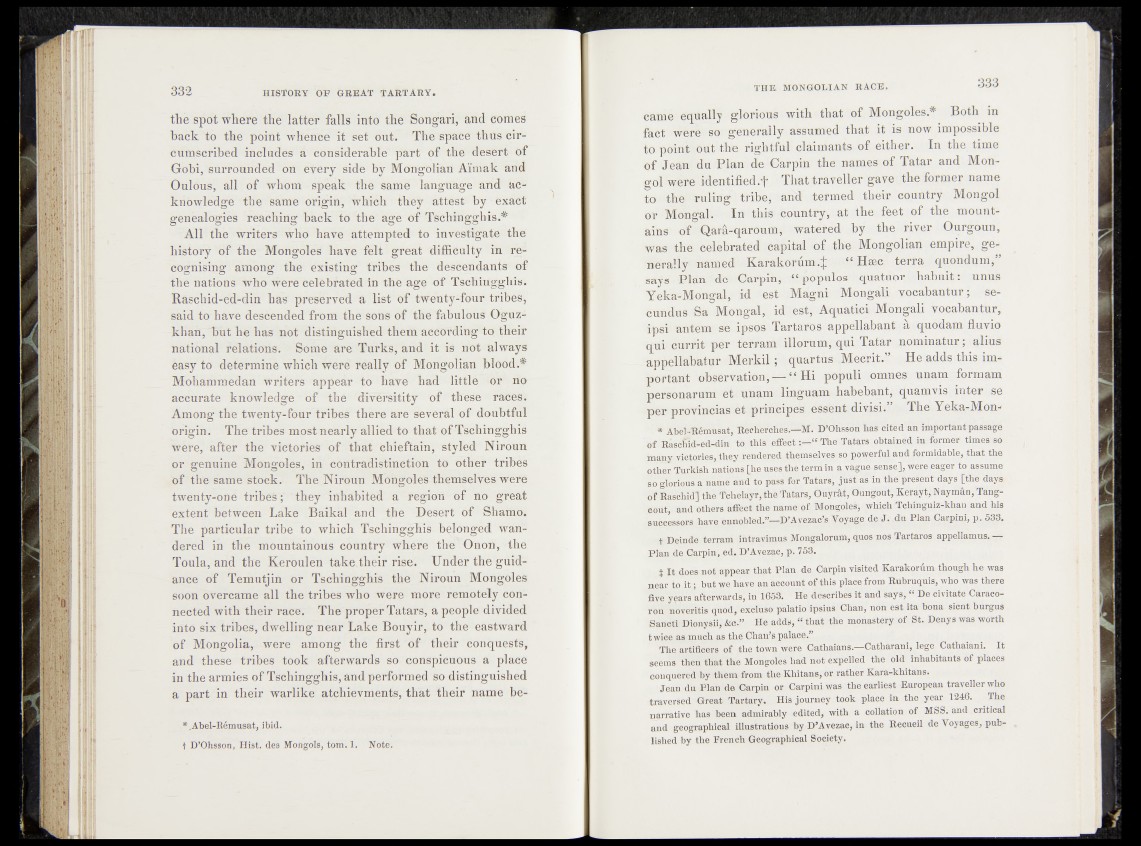
the spot where the latter falls into the Songari, and comes
hack to the point whence it set out. The space thus circumscribed
includes a considerable part Of the desOrt of
Gobi, surrounded bit every side by Mongolian Aimak and
OulouS; all of whom speak the same' language and acknowledge
the same origin, which they attest by exact
genealogies reaching back to the age of Tschingghis.*
All the ^Writers who' have attempted to investigate the
history bf the'Mongoles have felt great difficulty ^
cognising: among: the existing tribes tho • descendants of
the nations who were celebrated in the age of Tschingghis.
Raschid-ed-din has preserved a list of twenty-four tribee,
said to have descended from the*Sons of the fabulous Oguz-
khatfj'but he has not distinguished theih ac’cordingifcci their
national relations. Some are Turks, hnd it is h!OtN'alwayS
easy to determine which Were really of MOfl^iian bfejpd.*
Mohammedan writers appear to have had? ^little *or no
accurate knowledge of the 'diversitity of tmpftii races.
Among the twenty-four tribeS there are. several of tfouhtful
origin. The tribes most nearly allied do that of-Tschingghis
were, after the victories of that chieftain, siMcd'" Niroun
or genuine Mongoles, in contradistinction to O-ther tribes
bf 'the same stoek. The Niroun Mongolesthemselves were
twenty-one tribes;' they inhabited a region of no great
extent between Lake Baikal and the Desert of-' Shatno.
The particular tribe to which TschinggHis belonged wandered
in the mountainous country where theYOnoh, th e
Toula, and the Keroulen take.their rise. Under the guidance
of Temutjin or Tscbingghis the Niroun Mongoles
soon overcame all the tribes who were more remotely connected
with their race. The proper Tatars, a people divided
into six tribes, dwelling near Lake Bouyir, to the eastward
of Mongolia, were among the first of their conquests,
and these tribes took afterwards so conspicuous a place
in the armies of Tschingghis, and performed So distinguished
a part in their warlike atchievments, that their name be*
*, Abel-Rémusat, ibid.
t D’Ohsson, Hist, des Mongols, tom. 1. Note.
came equally glorious• with that of Mongoles* Both in
fact were so-generally assumed that it is now impossible
to p0 i@ft*oat4 h?e rightful claimants of either. In the time
of Jean du Plan die Garpin the names of Tatar and Mongol
wère‘-identified;^ That traveller gave the former name
M the: -ruling-tribe, and?', termed their country Mongol
or Móngal. In this-'-country, at the, feet of the mountains
of Qarfi-qaroumv watered,“ by the river Ourgoun,
was the celebrated capital/of the Mongolian empire, ge-
her ally named Earakorum:$t- “ Hsec terra quohdum,”
Safs Plan ‘ de^G'arpih,*' “ populos ; quatuor habuit: unus
Yeka-Morigal, -id Magni Monga^ YOcabantur; secundus
A Mongal, idl|^%'-Aquatick MongaU vocabantUr,
i,p&x?laèfënv sC-ipsoWTartaros appellabant.a.quodam fluvio
qui- currit per tóöam‘ illbrum, qui Tatar nominatur; alius
- ajtpillabatur Merkil; quartus ,Meerit.”" He adds this important
observation, —“ Hi populi omnes unam formam
personarum et unam linguam habebant, ^juamvis inter sé
provin ciasüét jjp rift^ipeS essentf divisi;*:$É The Yeka-Mon*
* AberfhSri'usat, k^?hefcïiè8.—M.' D’Ohsson haS bifid an important passage
'o f RascMff-ed-dSs to 'this e f f e c t “ The Tatars obtained in.former times so
^hd-^ormWable, that the
p{her. Turkish B^.io5M ^ ^ e# h e tend in^ 4 ^ ^ W ^ w |r e |a g & r 'to assqine
a'name and'to pass W Tatars', just as in tiie present days [the day»
8^tR¥s‘chMJthe.¥chelayr,the Tatars, Ouyr&t, ©ungout, Kerayt, Nayman, Tange
n t , and others affect ;the name of Mongoles-,* whiph Tchinguiz-khan and his
successors have cnnQhredi.gte^B’A,yezac’s Voyage ^LWdn Plan Ca.rpini, p, 533.
-vpDeinde terram ïhtravimus Mpngalorum, quos nos Tartaros appellamus. —
Plan da.Carpin, ed,4p ’Ayez£c, p. 753.
j It-does, nob appear, that Plai^d^G^pin visited.-Karakorffmgiough, Ije was
nepr to.itithujwe have an account o f this place from Rubruquis, who was there
five y^rs afterwards, in 1653. Hfe describes it and says, “ De civitate Caraco-
ron noveritis quod, excluso palatio ipsius Chan, don‘estsita bona sient burgus
SanmDionysii, &c.” He add#-, “-that -the monastery of St, Denys was worth
twiee as much as thp phan’s palace.”
The artificers of .the town were Cathaians.—Catjmrani,- lege Cathaiani. It
seems that' the Mongoles had b » inhabitants óf places
conquered'by them-from theKhitans, or rather Hara-khitan#--
Jean du Plan de Carpin op. Garpini was the earliest-European traveller who
traverééd Great Tartary, HiS jopmey took place in the year 1246. The
narrative has- beefi admirably edited, with a collation of MSS.-ahd critical
and geographical illustrations ia&D’Avezac, in the Recueil de Voyages, published
by the French Geographical Society.